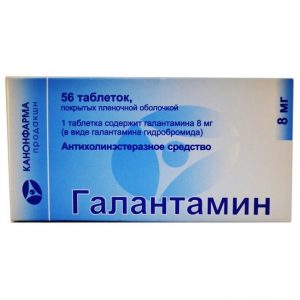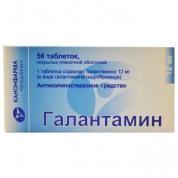Description
Release form
Tablets.
Packing
30 pcs.
Pharmacological action of
Rexetin is an antidepressant that blocks the reuptake of serotonin by the presynaptic membrane, which allows the serotonergic effect in the central nervous system to increase, resulting in an antidepressant effect.
The drug improves behavior and cognitive function.
Indications
Depression of various etiologies, incl. conditions accompanied by anxiety.
Obsessive-compulsive disorder (obstruction syndrome).
Panic disorders, including with fear of being in the crowd (agoraphobia).
Sociophobia.
Generalized Anxiety Disorder (GAD).
Post-traumatic stress disorder.
Also used as part of anti-relapse treatment.
Contraindications
Hypersensitivity, pregnancy, lactation, atony of the bladder, severe renal failure (glomerular filtration <10 ml / min), glaucoma, prostate adenoma, convulsive syndrome of various origins, epilepsy, diabetes mellitus. The drug cannot be used in combination with MAO inhibitors. Use during pregnancy and lactation The safety of paroxetine during pregnancy has not been studied, therefore, it should not be used during pregnancy and lactation, unless, from a medical point of view, the potential benefit of treatment exceeds the possible risk associated with taking the drug. If you need to use the drug during lactation, you should decide whether to stop breastfeeding. During the period of use of the drug, women of childbearing age should avoid conception (use reliable methods of contraception). Special instructions The use of paroxetine at the same time as MAO inhibitors and for 14 days after their withdrawal is contraindicated. In the future, paroxetine should be used with extreme caution, starting a course of treatment with small doses and gradually increasing dosages to achieve the desired therapeutic effect. After the end of paroxetine therapy for 14 days, it is impossible to start a course of treatment with MAO inhibitors. If the patient was previously in a manic state, the possibility of relapse should be considered while taking paroxetine (as with other antidepressants). There is insufficient experience with the simultaneous use of electroconvulsive therapy and paroxetine. Due to the predisposition to suicidal attempts in patients with depression and patients with drug addiction during the withdrawal period, this category of patients needs careful monitoring during treatment. In many cases, hyponatremia has been observed, especially in elderly patients who receive diuretics. After the withdrawal of paroxetine, the level of sodium in the blood normalizes. In some cases, increased bleeding (mainly ecchymosis and purpura) occurred during treatment with paroxetine. Hyperglycemic conditions have rarely been reported with paroxetine. Suicide / Suicidal Thinking Depression is associated with an increased risk of suicidal thoughts, auto-aggression, and suicide. This risk remains until remission occurs. Since improvement may not occur within the first few weeks or more from the start of treatment, patients should be carefully monitored until such improvement occurs. Existing clinical experience suggests that when treated with antidepressants, the risk of suicide may increase in the early stages of recovery. Other psychiatric conditions in which Rexetin is prescribed, may also be associated with an increased risk of suicidal behavior. In addition, these conditions may be concomitant with major depressive disorder. The same precautions as in the treatment of patients with major depressive disorder should be followed when it comes to treating patients with other psychiatric disorders. Patients with a history of suicidal behavior or thoughts, or who show a significant degree of suicidal ideation before starting treatment, are at greater risk of suicidal thoughts or suicide attempts, and should be closely monitored during treatment. In such patients aged 18-29, there is an increased risk of suicide, so treatment with the drug should be carefully monitored. Patients (and those who provides care to patients) should be prepared for the need for control in emergency situations – the appearance of suicidal intentions / behavior or thoughts of auto-aggression, in order to seek medical help immediately if these symptoms are present. Influence on the ability to drive vehicles and control mechanisms Controlled studies have not revealed a negative effect of paroxetine on psychomotor or cognitive function. Despite this, at the beginning of the course of therapy, for an individually set period, you can not drive a car or work in conditions of increased danger, requiring a quick reaction. The degree of restriction is determined individually. Composition 1 coated tablet contains: Active substance: paroxetine hydrochloride hemihydrate 22.76 mg, which corresponds to a paroxetine content of 20 mg. Excipients: hypromellose – 15 mg calcium hydrophosphate dihydrate – 244.24 mg sodium carboxymethyl starch – 15 mg magnesium stearate – 3 mg Film sheath: macroglol srdlp 400 mg – 7 mg – 7 macrogol 6000 – 0.956 mg polysorbate 80 – 0.044 mg titanium dioxide – 1.03 mg. Dosage and administration Take orally in the form of tablets. Usual Adult Dose 20 mg (0, 02 g) 1 time per day (usually taken in the morning). If necessary and well tolerated, you can increase the dose by 10 mg at 1 week intervals to a maximum dose of 50 mg per day (elderly people up to 40 mg per day). Side effects Side effects are presented with the percentage of the detected ratio of the total number of patients treated with this treatment). From the digestive system: Nausea (12%) sometimes – constipation, diarrhea, decreased appetite rarely – increased liver function tests in some cases – severe liver dysfunction. A causal relationship has not been proven between the use of paroxetine and a change in the activity of liver enzymes, but in case of impaired liver function, the use of paroxetine is recommended. From the side of the central nervous system and peripheral nervous system: Drowsiness (9%) tremor (8%), general weakness and increased fatigue (7%), Insomnia (6%) sometimes – headache, increased irritability, Paresthesia, Dizziness, somnambulism rarely – Extrapyramidal disorders syndromes, orofacial dystonia. Extrapyramidal disorders are noted mainly with previous intensive use of antipsychotics. In some cases, epileptiform seizures (which is also characteristic of therapy with other antidepressants) increase in intracranial pressure. From the autonomic nervous system: Increased sweating (9%), dry mouth (7%). On the part of the organ of vision: In some cases – impaired vision, mydriasis rarely – an attack of acute glaucoma. From the cardiovascular system In some cases – tachycardia, ECG changes, blood pressure lability, fainting. On the part of the reproductive system: Disorder of ejaculation (13%), in some cases – a change in libido. From the urinary system Rarely – difficulty urinating. On the part of the water-electrolyte balance: In some cases, hyponatremia with the development of peripheral edema, impaired consciousness or epileptiform symptoms. After discontinuation of the drug, the level of sodium in the blood normalizes. In some cases, this condition developed due to the overproduction of antidiuretic hormone. Most of these cases were observed in elderly people who, in addition to paroxetine, received diuretics and other drugs. Allergic reactions: Rarely – skin hyperemia, subcutaneous hemorrhage, swelling in the face and limbs, anaphylactic reactions (urticaria, bronchospasm, angioedema), skin itching. Other: In isolated cases – myopathy, myalgia, hyperglycemia rarely – hyperprolactinemia, galactorrhea, hypoglycemia, fever and the development of the flu-like state in some cases – thrombocytopenia (a causal relationship with the drug has not been proven). Taking paroxetine may be accompanied by an increase or decrease in body weight. Several cases of increased bleeding have been described. Drug interactions Food and antacids do not affect the absorption and pharmacokinetics of paroxetine. Like other serotonin reuptake inhibitors, in animal experiments an undesirable interaction was observed between MAO inhibitors and paroxetine. Concomitant use of paroxetine with tryptophan leads to headache, nausea, increased sweating and dizziness, therefore, the use of this combination should be avoided. A pharmacodynamic interaction is suggested between paroxetine and warfarin (with unchanged prothrombin time, increased bleeding is noted) the use of this combination requires caution. When combined with paroxetine and sumatriptan, general weakness, hyperreflexia, and impaired coordination are noted. If necessary, their simultaneous use should be particularly careful (requires medical supervision). With the simultaneous use of paroxetine, it can inhibit the metabolism of tricyclic antidepressants (due to inhibition of the CYP2D6 isoenzyme), therefore, the use of this combination requires caution and a reduction in the dose of tricyclic antidepressants. drugs, which enhance or inhibit the activity of the liver enzyme systems, can affect the metabolism and pharmacokinetics of paroxetine. When combined with inhibitors of metabolic enzymes of the liver, it is necessary to use the lowest effective dose of paroxetine. Joint use with inducers of liver enzymes does not require correction of the initial dose of paroxetine. A further change in dosage depends on the clinical effect (effectiveness and tolerability). Paroxetine significantly inhibits the activity of the CYP2D6 isoenzyme. Therefore, special care requires the simultaneous use of paroxetine with drugs, the metabolism of which occurs with the participation of this isoenzyme, including with certain antidepressants (e.g. nortriptyline, amitriptyline, imipramine, desipramine and fluoxetine), phenothiazines (e.g. thioridazine), class 1 C antiarrhythmic drugs (e.g., propafenone, flecainide and encainide) or with drugs that block its action (e.g., quinidine, cimetidine, codeine). toThere are no reliable clinical data on the inhibition of CYP3A4 isoenzyme by paroxetine, therefore, it is possible to use drugs that inhibit this enzyme (for example, terfenadine). Cimetidine inhibits certain cytochrome P450 isoenzymes. As a result, with the combined use of paroxetine with cimetidine, the level of paroxetine in the blood plasma rises at the equilibrium state. Phenobarbital increases the activity of certain cytochrome P450 isoenzymes. With the combined use of paroxetine with phenobarbital, the concentration of paroxetine in the blood plasma decreases, and its T1 / 2 is also shortened. With the combined use of paroxetine and phenytoin, the concentration of paroxetine in the blood plasma decreases and the frequency of side effects of phenytoin may increase. When using other anticonvulsants, the incidence of their side effects may also increase. In patients with epilepsy treated for a long time with carbamazepine, phenytoin, or sodium valproate, the additional appointment of paroxetine did not cause changes in the pharmacokinetic and pharmacodynamic properties of anticonvulsant drugs to increase paroxysmal convulsive readiness. Paroxetine is highly bound to plasma proteins. With simultaneous use with drugs that also bind to plasma proteins, an increase in side effects is possible against a background of an increase in the concentration of paroxetine in blood plasma. Due to the lack of sufficient clinical experience with digoxin and paroxetine, the use of this combination requires caution. Diazepam with topical application does not affect the pharmacokinetics of paroxetine. Paroxetine significantly increases the concentration of procyclidine in blood plasma, therefore, when anticholinergic side effects appear, it is necessary to reduce the dose of procyclidine. In clinical trials, paroxetine did not affect the level of propranolol in the blood. In some cases, an increase in theophylline concentration in the blood was noted. Despite the fact that during clinical trials the interaction between paroxetine and theophylline has not been proven, regular monitoring of theophylline levels in the blood is recommended. Strengthening the action of ethanol with simultaneous use with paroxetine not detected. However, due to the effect of paroxetine on the liver enzyme system, it is necessary to exclude the use of alcohol during treatment with paroxetine. Overdose Symptoms: nausea, vomiting, tremor, pupil enlargement, dry mouth, general arousal, sweating, drowsiness, dizziness, facial skin hyperemia. No coma or seizures were observed. The fatal outcome was rarely noted, usually with concomitant overdose of paroxetine and other drug causing adverse interactions. Signs of overdose are manifested with the simultaneous use of 2 g of paroxetine or when receiving a large dose of paroxetine with other drugs or with alcohol. Paroxetine therapy is safe in a large dose range. Treatment: gastric lavage, 20-30 g of activated charcoal every 4-6 h for the first 24-48 h should clear the airways, if necessary carry out oxygenation. They monitor vital functions of the body and general activities aimed at maintaining them. There is no specific antidote. Forced diuresis, hemodialysis, or hemoperfusion are ineffective if a large dose of paroxetine is received from the blood into the tissue. Storage Conditions The product is recommended to be stored at 15 ° C to 30 ° C. Shelf life 4 years. Deystvuyushtee substance Paroxetine Terms and conditions prescription dosage form tablets Possible product names REKSETIN 0, 02 N30 TABLE P / FILM / SHELL Rexetin 20mg Tab. cover captivity. about. X30 (R) REKSETIN 20MG. No. 30 TAB. P / O / GEDEON RICHTER / Rexetin tab p / p / o 20mg N30 (pack contact N10x3) REKSETIN TAB. P.P.O. 20MG No. 30 Gideon Richter, Vengriya




